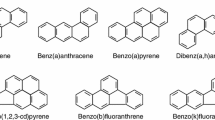Abstract
Numerous wood preserving waste (WPW) sites in the United States pose genotoxic hazards. WPWs consist of complex mixtures containing toxic, including genotoxic, compounds which are derived from the preservatives coal tar creosote and pentachlorophenol (PCP) and other polychlorinated aromatics. The genotoxicity of WPW extracts, which has not been tested in mammals, cannot be evaluated on the basis of data for individual components because of possible compound interactions. Therefore, whole extracts need to be assayed. 32P-postlabeling represents a powerful tool to determine DNA adduct formation by complex genotoxic mixtures, such as cigarette smoke, diesel exhaust, and coke oven and foundry emissions in experimental animals and humans. In the present study, a mouse bioassay was used in combination with 32P-postlabeling to determine DNA adduct formation induced by hexane/acetone extracts of two samples from a WPW site. Female ICR mice were treated dermally with extract corresponding to 3 mg residue or vehicle control once per day for 2 days and killed 24 h later. Skin, lung, liver, kidney, and heart DNA preparations were assayed by nuclease P1-enhanced postlabeling. Adduct profiles were tissue-specific and displayed a multitude of non-polar DNA adducts with levels amounting to one adduct in 1.6×106 DNA nucleotides in skin (both extracts) and one adduct in 3.2×107 or 1.2×107 DNA nucleotides in liver (extract 1 or extract 2). Based on their chromatographic properties, these adducts appeared largely derived from polycyclic aromatic hydrocarbons (PAHs) present in the extracts. One of the major adducts was identified as the 32P-labeled derivative of the reaction product of 7β,8α-dihydroxy-9α,10α-epoxy-7,8,9,10-tetrahydrobenzo[a]pyrene (BPDE I) with N 2 of deoxyguanosine. Total non-polar DNA adduct levels were highest in skin and lung, amounting to 17.4 and 24.0% of the skin values for extracts 1 and 2, respectively, in lung while the corresponding levels in liver were 5.0 and 12.6%. These results were in accord with the carcinogenic potencies of PAHs in these organs. Extract 2 induced higher adduct levels in internal organs, although its PAH concentrations were lower than those of extract 1, i.e. lung, liver, kidney, and heart had 1.4, 2.5, 1.9, and 1.7 times higher total adduct levels and 1.6, 3.3, 1.6, and 1.9 times higher benzo[a]pyrene adduct levels. With the exception of total adducts in lung, the differences between the two extracts were all significant, suggestive of compound interactions. The benzo[a]pyrene adduct levels in the five tissues correlated linearly with total adduct levels and thus represented a surrogate for the latter. Overall, the results suggest that DNA adducts in mouse tissues, as analyzed by 32P-postlabeling, are suitable biomarkers and dosimeters of the genotoxicity of WPW extracts.
Similar content being viewed by others
Author information
Authors and Affiliations
Additional information
Received: 26 September 1995/Accepted: 7 December 1995
Rights and permissions
About this article
Cite this article
Randerath, E., Zhou, GD., Donnelly, K. et al. DNA damage induced in mouse tissues by organic wood preserving waste extracts as assayed by 32P-postlabeling. Arch Toxicol 70, 683–695 (1996). https://doi.org/10.1007/s002040050329
Issue Date:
DOI: https://doi.org/10.1007/s002040050329




